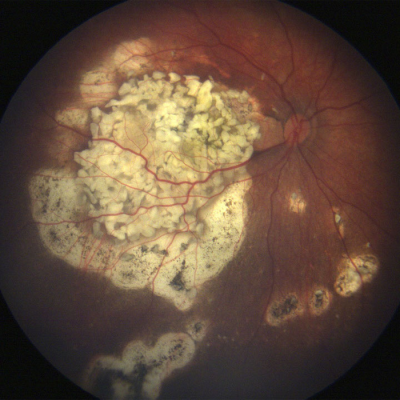
Inactive remnant of retinoblastoma tumor following successful intra-arterial chemotherapy. Image credit: UT Southwestern Medical Center.
Despite decades of medical advances, children who develop the pediatric eye cancer retinoblastoma often lose their vision or an eye due to a lack of specific, targeted therapies and a poor molecular understanding of the cancer. Now researchers at UT Southwestern and the University of Miami have discovered that a molecule – estrogen-related receptor gamma, or ESRRG – becomes hyperactive and promotes tumor cell survival in retinoblastoma. Blocking ESRRG, the team reported in Science Advances, kills retinoblastoma cells.
“Our discovery could lead to innovative new treatments for this cancer that take advantage of this dependence of retinoblastoma on ESRRG,” said study leader J. William Harbour, M.D., Chair and Professor of Ophthalmology at UT Southwestern.
In the new study, Dr. Harbour and his colleagues analyzed genes and proteins in tumor cells from 103 retinoblastoma patients, representing the largest sequencing analysis of retinoblastoma reported to date. While 94% of the tumors contained RB1 mutations, many also contained other altered genes. When the scientists analyzed these other mutations, they discovered that many were involved in the same signaling pathway inside cells: a molecular network that regulates ESRRG. ESRRG is known to play a role in the early development of the retina and other components of the nervous system but had never been linked to retinoblastoma before.